Starbucks Corporation
2401 Utah Avenue South
Seattle, WA 98134
(206) 447-1575
www.starbucks.com
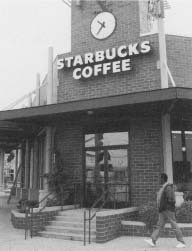
Starbucks began selling roasted arabica coffee beans from a small shop in Seattle, Washington, in 1971. Through taste tests and word of mouth, Starbucks coffee soon became the beverage of choice among coffee drinkers of all ages, and additional Starbucks stores opened in Seattle and in the state of Washington. Yet what truly made Starbucks an American icon was the opening of its coffee bars, where customers were served a variety of coffees in a relaxed atmosphere filled with distinctive background music. From its earliest coffee bar in 1984 to over five thousand locations in 2002, Starbucks has become an international phenomenon with sales of over $2.65 billion worldwide.
All about the Beans
The story of Starbucks is all about the beans—coffee beans. Writer Gordon Bowker loved coffee, especially the dark aromatic blends he had tasted during a trip to Italy. Italian coffee beans, however, were not available in Seattle, Washington, where he lived. Bowker did find a source for beans in Canada, and to satisfy his craving and that of friends and colleagues at Seattle magazine where he worked, Bowker found himself traveling to Vancouver, British Columbia, more and more frequently during the 1960s.
After the magazine went out of business, Bowker and two friends, Gerry Baldwin and Zev Siegl, decided to start a company to bring Italian coffee beans to Seattle. They came up with about $10,000 to launch their company, and picked an unusual name for their gourmet coffee venture: "Starbucks." The name was a marketing tactic, since many retail analysts believed company names beginning with the "st" sound were remembered more clearly than others. Some say, however, that the name Starbucks was taken from a character in Moby-Dick, the famous novel by Herman Melville (1819-1891). Whichever story is true, the name was destined for greatness, as was the logo the partners came up with to stamp on their product—a longhaired mermaid with a split tail.
The Starbucks partners began by going to a coffee master, Alfred Peet, who owned and operated Peet's Coffee in California and was famous for his expertly roasted coffee beans. The partners wanted to follow in his footsteps, so they bought dark arabica beans from Peet, learned how to roast them, and began brewing their own coffee. They opened their first store in 1971 in Seattle, in a bustling market area called Pike's Place.
Starbucks at a Glance
- Employees: 47,000
- CEO: Orin C. Smith
- Subsidiaries: Starbucks Coffee International, Inc.; Starbucks Ice Cream Partnership; Coffee Connection; Tazo Tea Company; Peet's Coffee Company; Seattle Coffee Company; Pasqua Inc.
- Major Competitors: Caribou Coffee; Diedrich Coffee; Green Mountain Coffee; Seattle's Best Coffee; Second Cup Ltd.
- Notable Products: Frappuchino bottled drinks; Hear Music; Starbucks Barista Athena espresso machine; Starbucks Barista Burr grinder; Starbucks ice cream; Tazo teas
To lure customers, Starbucks gave away free coffee samples to anyone passing by. The simple plan worked and people began to return for the rich, dark coffee unlike any they had tasted at home or work. Starbucks unique coffee had no bitter aftertaste like most coffees sold in grocery stores by the can or even served in restaurants. Since the only place to get Starbucks coffee was at the Starbucks store, the partners soon had a hit and enough money to open a second shop in University Village in 1972.
Timeline
- 1971:
- The first Starbucks opens in Seattle, Washington.
- 1982:
- Howard Schultz is hired as marketing director.
- 1984:
- Schultz opens his first II Giornale coffee bar serving Starbucks coffees.
- 1987:
- Schultz and II Giornale acquire Starbucks; name changes to Starbucks Corporation.
- 1988:
- Company launches mail-order catalog.
- 1990:
- Starbucks secures contract with Horizon Air; builds a new roasting plant.
- 1991:
- The first airport kiosk opens in Seattle.
- 1992:
- Nordstrom department stores begin selling Starbucks coffee.
- 1993:
- Company signs deal with Barnes & Noble.
- 1994:
- Sheraton hotels (now Starwood Hotels) begin serving Starbucks.
- 1995:
- Company begins packaging and selling music CDs; secures contract with United Airlines; Frappuccino is introduced.
- 1996:
- Locations open in Japan and Singapore; Starbucks ice cream is introduced.
- 1997:
- Starbucks opens in the Philippines; the Starbucks Foundation is established.
- 1998:
- Starbucks opens in Malaysia, New Zealand, Taiwan, Thailand, and the United Kingdom; products begin appearing in grocery stores.
- 1999:
- New stories open in China, Kuwait, Korea, and Lebanon.
- 2000:
- Starbucks is launched in Saudi Arabia and Hong Kong; Marriott hotels begin serving Starbucks.
- 2001:
- Company signs contract with Hyatt hotel chain; new shops open in Austria, Israel, and Switzerland.
- 2002:
- There are 5,500 Starbucks worldwide in twenty countries.
Within ten years, Starbucks was booming with five stores and its own bean-roasting plant. The partners had also begun selling coffee beans to some area restaurants. Having the firm's name associated with successful eateries not only gave the Starbucks name a boost, but serving it helped build the brand's status as a quality coffee. To help keep up with demand for Starbucks products, Howard Schultz was hired as marketing director in 1982; his guidance proved pivotal to the young company's future.
Starbucks Takes Off
In 1983, Schultz went to Italy to sample coffees and was charmed by the country's espresso bars—long counters with pull-up seats and a casual atmosphere. He believed a similar setup would benefit Starbucks in Washington. Bowker, Baldwin, and Siegl, however, were not as convinced and declined to pursue the new venture, although they did offer to help finance Schultz. Naming his new coffee bar Il Giornale Coffee Company to reflect his Italian inspiration, Schultz opened his doors in downtown Seattle in 1984.
Il Giornale served Starbucks coffee, but also invited customers to sample different kinds of coffee beverages, including espresso—coffee's much richer, stronger cousin. The laid-back, friendly atmosphere became a popular alternative to fast-food outlets or even restaurants, welcoming patrons to linger and relax. Il Giornale was a success, and Schultz soon made plans to open more stores.
While II Giornale tested the coffee bar theory, Starbucks bought Peet's Coffee & Tea in 1985. The partners, however, became a little restless. Schultz, fresh from his Il Giornale triumph, offered to buy them out for $3.8 million. Bowker, Baldwin, and Siegl sold their shares to Schultz, but kept Peet's Coffee & Tea business. Schultz then combined Starbucks with II Giornale and renamed the whole operation Starbucks Corporation in 1987. All Il Giornale locations became Starbucks, for a grand total of seventeen, and while Schultz made plans to build Starbucks coffee bars across the United States.
During 1988, Starbucks doubled the number of its locations and introduced a mail-order catalog, making the brand available to customers in all fifty states. An advanced computer system had been installed at the Seattle headquarters, as well as in each Starbucks location, to monitor sales and inventory.
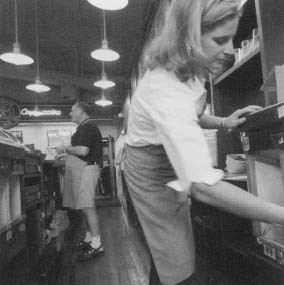
A Cultural Phenomenon
The new decade brought immense growth for Starbucks, including the opening of its first airport shop in Seattle in 1991. Nordstrom signed on to serve Starbucks coffees in its department stores in 1992, and Barnes & Noble began offering Starbucks coffee in its bookstores in 1993. The company began its move into charity, by donating thousands of coffee sample packs to CARE, an international relief organization based in Atlanta, Georgia. Starbucks also changed from a private
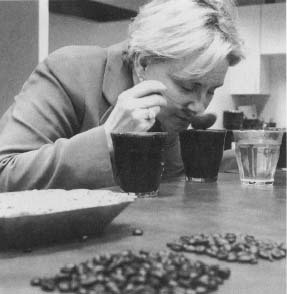
The money raised from selling stock paid for the company's explosive growth throughout the 1990s; by 1995 there were fifteen thousand employees (both full-and part-time) and new Starbucks were opening at a rate of one per week. Talking about the company with Bill McDowell of Restaurants & Institutions magazine, Schultz said, "We want to represent something more than a company that takes your money and sells you some coffee." As for the future, Schultz predicted, "People will be surprised not only with what we'll do, but how we'll do [it]."
True to his word, Schultz steered Starbucks to greater heights. To keep up with the growing demand, two additional bean-roasting facilities were opened just as competitors were starting to pop up. Schultz was not overly concerned; he spent his time and energy building the Starbucks brand both within the United States and outside it. Discussing Starbucks's competition in the Puget Sound Business Journal, John Rohs, a New York-based analyst of the restaurant and beverage industry declared that rival companies would not be able to "compete with the kind of guiding spirit Howard Schultz has brought to Starbucks." Allan Hickok, a financial analyst for Piper Jaffray in Minneapolis, Minnesota, made predictions too, stating to Restaurants & Institutions, "[Starbucks is] going to take over the world. There's nobody out there even close to matching them."
Competitors aside, Starbucks moved ahead at breakneck speed in 1996 to satisfy its four million weekly American patrons. New products included a joint venture with PepsiCo, Inc. (see entry) to sell flavored iced coffee drinks in bottles, called Frappuccino, and even ice cream, through a partnership with Dreyer's Grand, a premium ice cream producer. Starbucks also pushed into Asia, opening several shops in Japan and Singapore.
By the end of 1997, there were over fourteen hundred Starbucks locations, and the coffee retailer was opening a new shop nearly every day. Over the next two years the brand's beverages were available in a number of convenient places, including airlines (Horizon, United, and Canadian), hotels (Sheratons, Westins, Hiltons), bookstore chains, and grocery stores. The company had also started to buy competitors like the Boston-based Coffee Connection, with twenty-three stores; Seattle Coffee Company's sixty shops in the United Kingdom; and Pasqua Inc., a coffee retailer located in California. Schultz and Starbucks also continued to encourage social responsibility and the Starbucks Foundation, formed in 1997, helped promote literacy among children and teenagers.
To keep quality and freshness at their peak, coffee beans are not kept past eight days at any Starbucks location; any "old" coffee beans are donated to local shelters.
As Starbucks approached the end of the century, the firm created a Web site and continued its worldwide expansion with over 2,100 locations in the United States and abroad. According to the National Coffee Association, there were over seven thousand coffeehouses in America in 1999, up from only five hundred in 1991. Much of the credit for this tremendous growth was obviously due to Starbucks. To maintain its edge over rivals the company devised two new
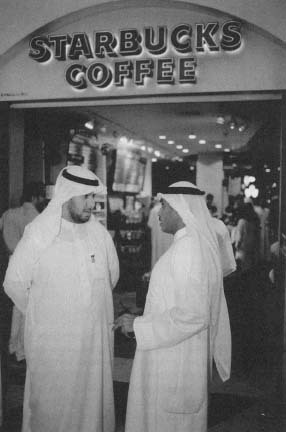
The Future of Starbucks
In 2000, Schultz pulled back a bit and turned over the duties of president and chief executive to Orin Smith, who had been hired back in 1990 as a vice president and chief financial officer (CFO). Schultz became chairman of the board and "chief global strategist," which kept him actively involved in the company he had taken from a handful of locations in 1985 to over 3,300 in 2000, with sales of over $2 billion.
Starbucks coffee and a wide range of other products, from teas and juices to sandwiches and music CDs, could be found all over the world in China, Hong Kong, Japan, and even the Middle East. And more hotel chains signed on to serve Starbucks beverages, including Marriott International and Hyatt Hotels. Another roasting plant, in Nevada, opened in 2001 along with Starbucks shops in Austria, Israel, and Switzerland. Japan celebrated the opening of its three hundredth location, which brought the total number of Starbucks, worldwide, to almost 5,500.
With this growth came an ongoing commitment to community awareness and giving to charitable causes. Starbucks gave over $1 million to struggling coffee farmers in developing countries after severe weather conditions threatened crops in 2000; teamed with Jumpstart, which finds tutors for kids in need; and continued its fight for literacy through the Starbucks Foundation with numerous grants given to schools and educational organizations. After the World Trade Center tragedy in New York City on September 11, 2001, Starbucks not only stayed open serving coffee to all the workers, but donated $1.2 million to the relief fund.
Starbucks served four hundred thousand customers a week in 1991. By 1995, there were three million customers per week, and by 2002 over twenty million coffee drinkers visited Starbucks each week in the United States.
Starbucks has come a long, long way from one shop in Seattle in 1971 to a global powerhouse with one of the most recognized names in the world. Although it is the number-one gourmet coffee retailer in the United States, the company's world coffee conquest is far from over. New locations in Spain were opened in 2002 and new shops were slated to open in Germany, Greece, Latin America, and Mexico late in the year and into 2003.
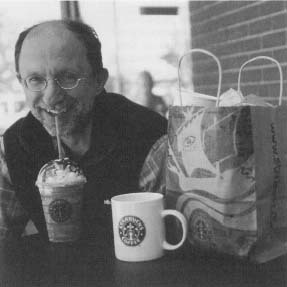
While many people flinched at paying a couple of bucks for a cup of coffee when it could be brewed at home for a quarter a cup, these same folks became devoted Starbucks customers after tasting its rich, flavorful coffees. Starbucks is more than just an excellent cup of coffee, it is an entire package—offering an inviting environment with chairs, tables, and even computers; fresh, premium brews and snacks; and soothing, unusual background music. It started with coffee beans but became a cultural experience for over twenty million Americans and millions more worldwide.
Comment about this article, ask questions, or add new information about this topic: